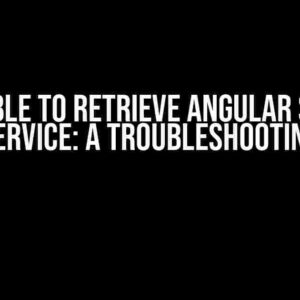Are you facing issues with Angular 18.0.5 not recognizing your interceptor? You’re not alone! Many developers have been stuck in this predicament, and we’re here to guide you through the troubleshooting process. In this article, we’ll explore the causes, solutions, and best practices to ensure your interceptor is working as expected.
What is an Interceptor in Angular?
Before we dive into the debugging process, let’s quickly refresh our memory on what an interceptor is in Angular. An interceptor is a powerful feature in Angular that allows you to intercept and modify HTTP requests made by your application. You can use interceptors to add headers, modify the request body, or even cancel the request altogether.
import { HTTP_INTERCEPTORS } from '@angular/common/http';
import { Injectable } from '@angular/core';
@Injectable()
export class MyInterceptor implements HttpInterceptor {
intercept(request: HttpRequest, next: HttpHandler): Observable> {
// Your interceptor logic here
return next.handle(request);
}
}
Common Causes for Angular 18.0.5 Not Seeing the Interceptor
Now that we’ve covered the basics, let’s explore some common reasons why Angular 18.0.5 might not be recognizing your interceptor:
- Incorrect Module Importation**: Make sure you’ve imported the interceptor in the correct module, typically the app.module.ts file.
- Misconfigured Provider**: Verify that you’ve added the interceptor to the providers array in the module.
- Interceptor Not Implemented Correctly**: Double-check that your interceptor is implementing the HttpInterceptor interface correctly.
- Interceptor Not Registered in the HTTP_INTERCEPTORS Token**: Ensure that you’ve registered your interceptor in the HTTP_INTERCEPTORS token.
- Angular Version Issues**: If you’ve recently upgraded to Angular 18.0.5, some breaking changes might have affected your interceptor.
Troubleshooting Steps
Let’s go through a step-by-step guide to troubleshoot the issue:
- Verify Interceptor Implementation**: Check your interceptor implementation to ensure it’s correct. Make sure it’s implementing the HttpInterceptor interface and has the correct imports.
- Check Module Imports**: Verify that you’ve imported the interceptor in the correct module. Typically, this is the app.module.ts file.
- Inspect Providers**: Check that you’ve added the interceptor to the providers array in the module.
- Register Interceptor in HTTP_INTERCEPTORS Token**: Ensure that you’ve registered your interceptor in the HTTP_INTERCEPTORS token.
- Check Angular Version**: If you’ve recently upgraded to Angular 18.0.5, review the changelog to see if any breaking changes might be affecting your interceptor.
- Debug using Chrome DevTools**: Use Chrome DevTools to debug your application and inspect the HTTP requests. This can help you identify if the interceptor is being called or not.
| Step | Code Snippet | Description |
|---|---|---|
| 1 | import { HTTP_INTERCEPTORS } from '@angular/common/http'; |
Import the HTTP_INTERCEPTORS token |
| 2 | @NgModule({ providers: [{ provide: HTTP_INTERCEPTORS, useClass: MyInterceptor, multi: true }]}) |
Register the interceptor in the providers array |
| 3 | export class MyInterceptor implements HttpInterceptor { ... } |
Implement the HttpInterceptor interface |
Solutions to Common Issues
Let’s dive into some specific solutions to common issues:
Issue: Incorrect Module Importation
If you’ve imported the interceptor in the wrong module, try moving it to the app.module.ts file. Ensure that you’ve imported the correct module and added the interceptor to the providers array.
// app.module.ts
import { NgModule } from '@angular/core';
import { BrowserModule } from '@angular/platform-browser';
import { HttpClientModule } from '@angular/common/http';
import { MyInterceptor } from './my.interceptor';
@NgModule({
declarations: [AppComponent],
imports: [BrowserModule, HttpClientModule],
providers: [{ provide: HTTP_INTERCEPTORS, useClass: MyInterceptor, multi: true }],
bootstrap: [AppComponent]
})
export class AppModule {}
Issue: Misconfigured Provider
If you’ve added the interceptor to the providers array but still facing issues, try checking the provider configuration. Ensure that you’ve used the correct token (HTTP_INTERCEPTORS) and set the multi property to true.
// app.module.ts
import { NgModule } from '@angular/core';
import { BrowserModule } from '@angular/platform-browser';
import { HttpClientModule } from '@angular/common/http';
import { MyInterceptor } from './my.interceptor';
@NgModule({
declarations: [AppComponent],
imports: [BrowserModule, HttpClientModule],
providers: [{ provide: HTTP_INTERCEPTORS, useClass: MyInterceptor, multi: true }],
bootstrap: [AppComponent]
})
export class AppModule {}
Issue: Interceptor Not Implemented Correctly
If your interceptor implementation is incorrect, try reviewing the HttpInterceptor interface and ensuring that you’ve implemented it correctly.
// my.interceptor.ts
import { Injectable } from '@angular/core';
import { HttpInterceptor, HttpRequest, HttpHandler } from '@angular/common/http';
@Injectable()
export class MyInterceptor implements HttpInterceptor {
intercept(request: HttpRequest, next: HttpHandler): Observable> {
// Your interceptor logic here
return next.handle(request);
}
}
Best Practices for Interceptors in Angular 18.0.5
To avoid common issues and ensure your interceptor works as expected, follow these best practices:
- Use a consistent naming convention for your interceptors
- Place your interceptors in a separate file or folder for better organization
- Use the HTTP_INTERCEPTORS token to register your interceptors
- Implement the HttpInterceptor interface correctly
- Test your interceptors thoroughly to ensure they’re working as expected
By following these best practices and troubleshooting steps, you should be able to resolve the issue of Angular 18.0.5 not seeing your interceptor. Remember to stay calm, patient, and methodical in your approach, and you’ll be debugging like a pro in no time!
Conclusion
In this article, we’ve covered the common causes and solutions for Angular 18.0.5 not recognizing your interceptor. We’ve also explored best practices to ensure your interceptors work as expected. By following these guidelines, you’ll be well on your way to creating robust and efficient interceptors in your Angular application.
If you have any further questions or issues, feel free to ask in the comments below. Happy coding!
Frequently Asked Question
Angular 18.0.5 got you down? Don’t worry, we’ve got the answers to your interceptor woes!
Why isn’t my Angular 18.0.5 app seeing my interceptor?
Make sure your interceptor is properly registered in the providers array of your module. Also, double-check that you’re importing the HttpClientModule in the correct module, and that you’ve added the interceptor to the HTTP_INTERCEPTORS token.
Is there a specific order for registering interceptors in Angular 18.0.5?
Yes! When registering multiple interceptors, the order matters. Interceptors are executed in the order they’re registered. So, if you have multiple interceptors, make sure to register them in the correct order to avoid any unexpected behavior.
Can I use the same interceptor for multiple HTTP requests in Angular 18.0.5?
Absolutely! You can use the same interceptor for multiple HTTP requests by registering it once in the providers array of your module. The interceptor will then be applied to all HTTP requests made by your application.
How do I debug my interceptor in Angular 18.0.5?
To debug your interceptor, use the browser’s dev tools to set a breakpoint in your interceptor code. You can also use console logging or a debugging tool like Augury to inspect the request and response objects.
Are there any known issues with interceptors in Angular 18.0.5?
Yes, there are some known issues with interceptors in Angular 18.0.5. For example, if you’re using the Ivy renderer, you might encounter issues with interceptors not being called correctly. Check the official Angular documentation and GitHub issues for the latest information on known issues and workarounds.






